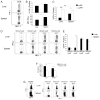Intrahepatic IL-10 maintains NKG2A+Ly49- liver NK cells in a functionally hyporesponsive state
- PMID: 20124099
- PMCID: PMC2885840
- DOI: 10.4049/jimmunol.0901362
Intrahepatic IL-10 maintains NKG2A+Ly49- liver NK cells in a functionally hyporesponsive state
Abstract
The tolerogenic nature of the liver allows daily exposure to gut-derived foreign Ags without causing inflammation, but it may facilitate persistent infection in the liver. NK cells play a central role in innate immunity, as well as in shaping the adaptive immune response. We hypothesized that the naive mouse liver maintains intrahepatic NK cells in a functionally hyporesponsive state. Compared with splenic NK cells, liver NK cells displayed a dampened IFN-gamma response to IL-12/IL-18 stimulation. Importantly, the liver contains a significant population of functionally hyporesponsive NK cells that express high levels of the inhibitory receptor NKG2A and lack expression of MHC class I-binding Ly49 receptors. Adoptively transferred splenic NK cells that migrate to the liver displayed phenotypic and functional changes, suggesting that the liver environment modifies NK cell receptor expression and functional responsiveness. Notably, IL-10 is present at high levels within the liver, and in vivo blockade of IL-10R resulted in a decreased percentage of intrahepatic NKG2A(+)Ly49(-) NK cells. These data suggest that the liver environment regulates NK cell receptor expression and that IL-10 contributes to the regulation of liver NK cells, in part, by maintaining a greater percentage of the hyporesponsive NKG2A(+)Ly49(-) NK cells in the liver.
Conflict of interest statement
The authors have no financial conflicts of interest.
Figures







Similar articles
-
Expression of the inhibitory receptor NKG2A correlates with increased liver and splenic NK cell response to activating receptor engagement.Immun Inflamm Dis. 2017 Jun;5(2):177-189. doi: 10.1002/iid3.156. Epub 2017 Mar 24. Immun Inflamm Dis. 2017. PMID: 28474506 Free PMC article.
-
Regulation of NK cell repertoire and function in the liver.Crit Rev Immunol. 2011;31(1):43-52. doi: 10.1615/critrevimmunol.v31.i1.40. Crit Rev Immunol. 2011. PMID: 21395510 Free PMC article. Review.
-
Synergized regulation of NK cell education by NKG2A and specific Ly49 family members.Nat Commun. 2019 Nov 1;10(1):5010. doi: 10.1038/s41467-019-13032-5. Nat Commun. 2019. PMID: 31676749 Free PMC article.
-
Frontline Science: A hyporesponsive subset of rat NK cells negative for Ly49s3 and NKR-P1B are precursors to the functionally mature NKR-P1B+ subset.J Leukoc Biol. 2017 Dec;102(6):1289-1298. doi: 10.1189/jlb.1HI0517-177RR. Epub 2017 Jul 26. J Leukoc Biol. 2017. PMID: 28747319
-
NK cell terminal differentiation: correlated stepwise decrease of NKG2A and acquisition of KIRs.PLoS One. 2010 Aug 6;5(8):e11966. doi: 10.1371/journal.pone.0011966. PLoS One. 2010. PMID: 20700504 Free PMC article.
Cited by
-
New and Old Key Players in Liver Cancer.Int J Mol Sci. 2023 Dec 5;24(24):17152. doi: 10.3390/ijms242417152. Int J Mol Sci. 2023. PMID: 38138981 Free PMC article. Review.
-
Natural killer cells limit cardiac inflammation and fibrosis by halting eosinophil infiltration.Am J Pathol. 2015 Mar;185(3):847-61. doi: 10.1016/j.ajpath.2014.11.023. Epub 2015 Jan 23. Am J Pathol. 2015. PMID: 25622543 Free PMC article.
-
Expression of the inhibitory receptor NKG2A correlates with increased liver and splenic NK cell response to activating receptor engagement.Immun Inflamm Dis. 2017 Jun;5(2):177-189. doi: 10.1002/iid3.156. Epub 2017 Mar 24. Immun Inflamm Dis. 2017. PMID: 28474506 Free PMC article.
-
Natural killer cells in inflammatory heart disease.Clin Immunol. 2017 Feb;175:26-33. doi: 10.1016/j.clim.2016.11.010. Epub 2016 Nov 25. Clin Immunol. 2017. PMID: 27894980 Free PMC article. Review.
-
Regulation of NK cell repertoire and function in the liver.Crit Rev Immunol. 2011;31(1):43-52. doi: 10.1615/critrevimmunol.v31.i1.40. Crit Rev Immunol. 2011. PMID: 21395510 Free PMC article. Review.
References
-
- Andrews DM, Scalzo AA, Yokoyama WM, Smyth MJ, Degli-Esposti MA. Functional interactions between dendritic cells and NK cells during viral infection. Nat Immunol. 2003;4:175–181. - PubMed
-
- Martín-Fontecha A, Thomsen LL, Brett S, Gerard C, Lipp M, Lanzavecchia A, Sallusto F. Induced recruitment of NK cells to lymph nodes provides IFN-gamma for T(H)1 priming. Nat Immunol. 2004;5:1260–1265. - PubMed
-
- Kim S, Iizuka K, Kang HS, Dokun A, French AR, Greco S, Yokoyama WM. In vivo developmental stages in murine natural killer cell maturation. Nat Immunol. 2002;3:523–528. - PubMed
Publication types
MeSH terms
Substances
Grants and funding
LinkOut - more resources
Full Text Sources
Molecular Biology Databases
Research Materials

